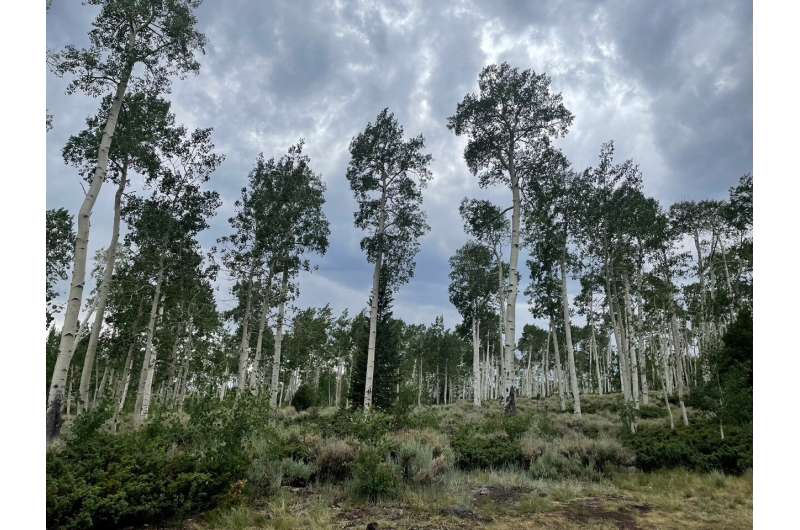Listening to the largest tree on Earth

Spread across 106 acres in southcentral Utah, the Pando aspen grove resembles a forest but is actually a single organism with more than 47,000 genetically identical aspen stems connected at the root. Pando is the world’s largest tree by weight and land mass. Research suggests Pando has been regenerating for 9,000 years, making it one of the oldest organisms on Earth.
As part of the 184th Meeting of the Acoustical Society of America, Jeff Rice and Lance Oditt described their work to reveal a unique acoustic portrait of this botanical wonder. Their presentation, “Beneath the tree: The sounds of a trembling giant,” took place Wednesday, May 10.
“Pando challenges our basic understanding of the world,” said presenter Jeff Rice, a sound artist from Seattle. “The idea that this giant forest could be a single organism defies our concept of the individual. Its vastness humbles our sense of space.”
After recording Pando’s leaves for The New York Times Magazine’s special issue “Listen to the World” in 2018, Rice returned in July 2022 as an artist-in-residence for the nonprofit group, Friends of Pando, which Oditt founded in 2019. Rice used a variety of microphones to record Pando’s leaves, birds, and weather.
“The sounds are beautiful and interesting, but from a practical standpoint, natural sounds can be used to document the health of an environment,” he said. “They are a record of the local biodiversity, and they provide a baseline that can be measured against environmental change.”
Rice was particularly captivated by the sound of vibrations passing through the tree during a windstorm. He wanted to see if they could record the sound of Pando’s root system, which can reach depths of 90 feet by some accounts. Oditt, executive director of Friends of Pando, identified several potential recording locations below the surface.
“Hydrophones don’t just need water to work,” said Rice. “They can pick up vibrations from surfaces like roots as well, and when I put on my headphones, I was instantly surprised. Something was happening. There was a faint sound.”
That sound is not conclusively from Pando’s root system. But a handful of experiments support the idea. Rice and Oditt were able to show that vibrations can pass from tree to tree through the ground. When they banged lightly on a branch 90 feet away, the hydrophone registered with a low thump. Rice compares this to the classic tin can telephone.
“It’s similar to two cans connected by a string,” he said. “Except there are 47,000 cans connected by a huge root system.”
A similar phenomenon occurred during a thunderstorm. As leaves moved more intensely in the wind, the signal recorded by the hydrophone also increased.
“The findings are tantalizing. While it started as art, we see enormous potential for use in science. Wind, converted to vibration (sound) and traveling the root system, could also reveal the inner workings of Pando’s vast hidden hydraulic system in a nondestructive manner,” said Oditt. “Friends of Pando plans to use the data gathered as the basis for additional studies on water movement, how branch arrays are related to one another, insect colonies, and root depth, all of which we know little about today.”
Citation:
Listening to the largest tree on Earth (2023, May 10)
retrieved 10 May 2023
from https://phys.org/news/2023-05-largest-tree-earth.html
This document is subject to copyright. Apart from any fair dealing for the purpose of private study or research, no
part may be reproduced without the written permission. The content is provided for information purposes only.
For all the latest Science News Click Here
For the latest news and updates, follow us on Google News.

